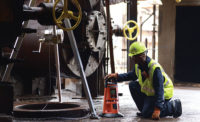Gas monitoring

Six years ago I penned an article discussing the benefits of fitting best work practices vs. pure regulatory compliance into gas monitoring processes. I discussed the benefits of going beyond simply what is required and taking the steps necessary to ensure that gas monitoring and confined space programs are providing the highest possible level of safety. I gave a clear call to action, urging employers to ensure their gas monitoring practices were providing workers with the best protection possible from hazardous gases. Further, I implored regulatory bodies to create and enforce rules that would dictate best practices in gas monitoring.
Today, as I reflect on the past year, I wonder whether or not we have made any progress towards the concept of making best practices in gas monitoring the rule rather than the exception. Was I expecting too much? Should we just simply be making sure we are complying with existing regulations before we begin to worry about whether or not we are performing the best practices to go along with them?
A deadly year
In my 20 years of experience in the gas detection world, I have never seen more press on explosions and accidents due to gases than in this past year. In fact, in the four years prior to this, the United States experienced just four deaths due to ignition/explosion of gas/dust compared to 17 deaths so far this year [U.S. Department of Labor]. This comes at a time when more and better gas monitoring instruments are being provided to industry than ever before. The question then must be, “Are the instruments being used and maintained properly, and in compliance with the regulations they are designed to support?â€(I will apologize in advance to all who strive to perform best safety practices, including OSHA STAR performers and members of VPPPA. In no way are you the targets of my concern.)
In the past year there have been numerous explosions that resulted in the injury or death of multiple workers. In any explosion scenario, the use and maintenance practices of the gas monitoring instruments are brought into question. When were the instruments last calibrated? Were they tested appropriately prior to use? Were gas monitors present and actually in use at the time of the explosion?
What is the problem?
How can these incidents continue to take place when there are clear requirements to ensure that they don’t, and when the instruments being used are equipped with features such as “last calibration dates†and “bump test logs†to help ensure that they are being used properly and in compliance with regulations? Is there a general lack of understanding of regulations, or do we just blatantly choose to ignore them?What is happening in the area of regulation and enforcement? In my aforementioned article, I chastised OHSA’s interpretation that a “calibrated instrument†used for confined space entry is one that is calibrated according to the manufacturer’s recommendations with no specific regard to frequency or verification of function between calibrations. Since that time, OSHA has posted, as a recommended practice, a statement of calibration drafted by the Industrial Safety Equipment Association, recommending periodic functional testing of gas monitoring instruments and monthly calibration intervals. While there is no enforcement of this as a legal requirement, it is a positive step toward best working practices.
How much safer would workers be, though, if the monthly calibration was mandated and compliance was enforced?
Bump test before using
As an engineer and designer of gas monitoring instruments, I have stressed for years that the only way to ensure that a gas detector is capable of actually sensing the gas it is designed to monitor is to test it with a known concentration of the gas. This supports the recommendation that portable gas monitors have a bump test performed on them before each use. Although there have been advancements in technology, this fact still holds true today. Unfortunately, there are few others making this same recommendation and still fewer that are actually undertaking the process.In Canada legislation has been enacted requiring a daily bump test of instruments in some provinces. Even so, the number of users inquiring about manufacturer’s recommendations and searching for recommendations that are in conflict with the legislation continues to increase; these users state that they feel no need to comply with the bump test rule if the manufacturer’s policy says otherwise. What are we doing?
Systems are available today that are built to automate the test, calibration and documentation requirements that industry does impose on the use of gas monitoring instruments. However, many users seem to be hesitant to utilize these types of docking station systems because they fear that the system’s exceptional documentation capabilities will point out areas where their program is non-compliant. To the contrary, these systems are designed to help ensure that users are performing in compliance with the regulations and moving toward adoption of best practices.
Expectations too high?
As you no doubt can tell, I am frustrated by the experiences of the past year. As manufacturers of gas detection equipment, we are in the business of saving lives and mortified by the thought of a single one being lost due to a gas accident when we can provide the tools to prevent it. Only when injury and death from gas accidents has been eliminated will we sleep soundly at night.Maybe the expectation that all users work to define and follow best practices in the industry with regard to gas monitoring equipment is too much. If only we were compelled to comply with the requirements to use and maintain them properly, maybe we would get to sleep faster.
Looking for a reprint of this article?
From high-res PDFs to custom plaques, order your copy today!



